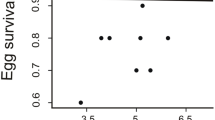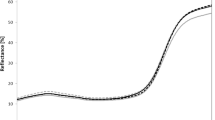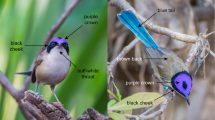Abstract
The handicap principle suggests that ornamental traits that function as honest signals in mate selection must be costly to be effective. We evaluated in the sexually monochromatic yellow-eyed penguin (Megadyptes antipodes) whether the carotenoid-derived plumage and eye coloration predicts parental quality and whether males and females within pairs mate assortatively in relation to these carotenoid-derived ornaments. In addition, we investigated whether age or body condition was related to the coloration of the ornamental traits. In yellow-eyed penguins, parental quality of males and females was predicted by eye and head plumage coloration. Even when we controlled for gender- and age-specific differences, eye and head plumage coloration reflected honestly parental quality. Males and females mated assortatively in relation to these ornamental traits. While age influenced coloration of both the eye and head plumage, body condition was related only to the saturation of plumage coloration. These results provide evidence that the carotenoid-derived ornaments in yellow-eyed penguins reflect the parental abilities of birds and, therefore, may be costly signals. Potentially, female and male yellow-eyed penguins could use eye and plumage coloration as an indirect cue in assessing age and quality of individual birds during mate choice. This is only the second study to examine plumage coloration in relation to sexual selection in penguins, while conspicuous ornamental traits in other species of penguin beg the question whether they also play a role in sexual selection.





Similar content being viewed by others
References
Adobe Systems (1994) Adobe Photoshop 3.0 user guide. Adobe, Mountain View, Calif.
Ainley DG, Emison WB (1972) Sexual size dimorphism in Adélie penguins. Ibis 114:267–271
Alatalo RV, Höglund J, Lundberg A (1988) Patterns of variation in tail ornament size in birds. Biol J Linn Soc 34:363–374
Amundsen T (2000) Why are female birds ornamented? Trends Ecol Evol 15:149–155
Amundsen T, Forsgren E, Hansen LTT (1997) On the function of female ornaments: male bluethroats prefer colourful females. Proc R Soc Lond B 264:1579–1586
Balmford A, Read AF (1991) Testing alternative models of sexual selection through female choice. Trends Ecol Evol 6:274–276
Bendich A (1989) Carotenoids and the immune response. J Nutr 119:112–115
Bendich A (1993) Biological functions of dietary carotenoids. Ann NY Acad Sci 691:61–67
Bortolotti GR, Iko W (1992) Non-random pairing in American kestrels: mate choice versus intra-sexual competition. Anim Behav 44:811–821
Bortolotti GR, Negro JJ, Tella JL, Marchant TA, Bird DM (1996) Sexual dichromatism in birds independent of diet, parasites and androgens. Proc R Soc Lond B 263:1171–1176
Bortolotti GR, Tella JL, Forero MG, Dawson RD, Negro JJ (2000) Genetics, local environment and health as factors influencing plasma carotenoids in wild American kestrels (Falco sparverius). Proc R Soc Lond B 267:1433–1438
Brush AH (1981) Carotenoids in wild and captive birds. In: Bauernfeind JC (ed) Carotenoids as colorants and vitamin A precursors. Academic Press, New York, pp 539–562
Brush AH (1990) Metabolism of carotenoid pigments in birds. J Fed Am Soc Exp Biol 4:2969–2977
Camplani A, Saino N, Møller AP (1999) Carotenoids, sexual signals and immune function in barn swallows from Chernobyl. Proc R Soc Lond B 266:1111–1116
Coulson JC, Duncan N, Thomas CS, Monaghan P (1981) An age-related difference in the bill depth of herring gulls Larus argentatus. Ibis 123:499–503
Cronin H (1991) The ant and the peacock. Cambridge University Press, Cambridge
Cuervo JJ, de Lope F, Møller AP (1996) The function of long tails in female barn swallows (Hirundo rustica): an experimental study. Behav Ecol 7:132–136
Darby JT, Seddon PJ (1990) Breeding biology of yellow-eyed penguins (Megadyptes antipodes). In: Davis LS, Darby JT (eds) Penguin biology. Academic Press, San Diego, Calif., pp 45–62
Darwin C (1871) The descent of man, and selection in relation to sex. Murray, London
Davis LS (1991) Mate choice and sexual dimorphism in penguins. Proc Int Ornithol Congr 20:1352–1360
Davis LS, Speirs EAH (1990) Mate choice in penguins. In: Davis LS, Darby JT (eds) Penguin biology. Academic Press, San Diego, Calif., pp 377–397
Fisher RA (1930) The genetical theory of natural selection. Clarendon Press, Oxford
Fitze PS, Richner H (2002) Differential effects of a parasite on ornamental structures based on melanins and carotenoids. Behav Ecol 13:401–407
Forero MG, Tella JL, Donázar JA, Blanco G, Bertellotti M, Ceballos O (2001) Phenotypic assortative mating and within-pair sexual dimorphism and its influence on breeding success and offspring quality in Magellanic penguins. Can J Zool 79:1414–1422
Fox DL (1979) Biochromy: natural coloration of living things. University of California Press, Berkeley, Calif.
Grafen A (1990) Biological signals as handicaps. J Theor Biol 144:517–546
Hamilton WD, Zuk M (1982) Heritable true fitness and bright birds: a role for parasites. Science 218:384–387
Hill GE (1990) Female house finches prefer colourful males: sexual selection for a condition-dependent trait. Anim Behav 40:563–572
Hill GE (1991) Plumage coloration is a sexually selected indicator of male quality. Nature 350:337–339
Hill GE (1993) Male mate choice and the evolution of female plumage coloration in the house finch. Evolution 47:1515–1525
Hill GE (1999) Is there an immunological cost of carotenoid-based ornamental coloration? Am Nat 154:589–595
Hill GE, Brawner WR III (1998) Melanin-based plumage coloration in the house finch is unaffected by coccidial infection. Proc R Soc Lond B 265:1105–1109
Hoelzer GA (1989) The good parent process of sexual selection. Anim Behav 38:1067–1078
Iwasa Y, Pomiankowski A, Nee S (1991) The evolution of costly mate preference II. The 'handicap principle'. Evolution 45:1431–1442
Johnstone RA, Reynolds JD, Deutsch JC (1996) Mutual mate choice and sex differences in choosiness. Evolution 50:1382–1391
Jones IL, Hunter FM (1993) Mutual sexual selection in a monogamous seabird. Nature 362:238–239
Jones IL, Hunter FM (1999) Experimental evidence for mutual inter- and intrasexual selection favouring a crested auklet ornament. Anim Behav 57:521–528
Jouventin P (1982) Visual and vocal signals in penguins, their evolution and adaptive characters. Adv Ethol 24:1–149
Jouventin P, Lequette B, Dobson S (1999) Age-related mate choice in the wandering albatross. Anim Behav 57:1099–1106
Kirkpatrick M, Ryan MJ (1991) The evolution of mating preferences and the paradox of the lek. Nature 350:33–38
Kodric-Brown A, Brown JH (1984) Truth in advertising: the kinds of traits favoured by sexual selection. Am Nat 124:309–323
Lande R (1980) Sexual dimorphism, sexual selection, and adaptation in polygenic characters. Evolution 34:292–305
Lande R (1981) Models of speciation by sexual selection on polygenic traits. Proc Nat Acad Sci USA 78:3721–3725
Ligon JD (1999) The evolution of avian breeding systems. Oxford University Press, Oxford
Lozano GA (1994) Carotenoids, parasites and sexual selection. Oikos 70:309–311
Massaro M, Darby JT, Davis LS, Edge K-A, Hazel MJ (2002) Investigation of interacting effects of female age, laying dates and egg size in Yellow-eyed Penguins (Megadyptes antipodes). Auk 119:1137–1141
Møller AP (1993) Sexual selection in the barn swallow Hirunda rustica III. Female tail ornaments. Evolution 47:417–431
Negro JJ, Bortolotti GR, Tella JL, Fernie KJ, Bird DM (1998) Regulation of integumentary colour and plasma carotenoids in American Kestrels consistent with sexual selection theory. Funct Ecol 12:307–312
Olsen VA, Owens IPF (1998) Costly sexual signals: are carotenoids rare, risky or required? Trends Ecol Evol 13:510–514
Owens IPF, Short RV (1995) Hormonal basis of sexual dimorphism in birds: implications for new theories of sexual selection. Trends Ecol Evol 10:44–47
Pomiankowski A, Iwasa Y, Nee S (1991) The evolution of costly mate preferences I. Fisher and biased mutation. Evolution 45:1422–1430
Reid WV (1988) Age correlations within pairs of breeding birds. Auk 105:278–285
Richdale LE (1957) A population study of penguins. Clarendon Press, Oxford
Rock CL, Jacob RA, Bowen PE (1996) Update on the biological characteristics of the antioxidant micronutrients: vitamin C, vitamin E, and the carotenoids. J Am Diet Assoc 96:693–702
Roulin A (1999) Nonrandom pairing by male barn owls (Tyto alba) with respect to a female plumage trait. Behav Ecol 10:688–695
Saetre GP, Fossnes T, Slagsvold T (1995) Food provisioning in the pied flycatcher: do females gain direct benefits from choosing bright-colored males? J Anim Ecol 64:21–30
Schantz T von, Bensch S, Grahn M, Hasselquist D, Wittzell H (1999) Good genes, oxidative stress and condition-dependent sexual signals. Proc R Soc Lond B 266:1–12
SPSS (2000) SPSS 10.0 for Macintosh, version 10.0.7a. SSPS, Chicago, Ill.
Tella JL, Forero MG, Donázar JA, Hiraldo F (1997) Is the expression of male traits in female lesser kestrels related to sexual selection? Ethology 103:72–81
Warham J (1975) The crested penguins. In: Stonehouse B (ed) The biology of penguins. Macmillan, London, pp. 189–269
Weimerskirch H (1990) The influence of age and experience on breeding performance of the Antarctic Fulmar, Fulmarus glacialoides. J Anim Ecol 59:867–875
Wiebe KL (2000) Assortative mating by color in a population of hybrid northern flickers. Auk 117:525–529
Wolfenbarger LL (1999) Red coloration of male northern cardinals correlates with mate quality and territory quality. Behav Ecol 10:80–90
Zahavi A (1975) Mate selection: a selection for a handicap. J Theor Biol 53:205–214
Zahavi A, Zahavi A (1997) The handicap principle: a missing piece of Darwin's puzzle. Oxford University Press, Oxford
Zuk M, Thornhill R, Ligon JD, Johnson K, Austad S, Ligon SH, Wilmsen Thornhill N, Costin C (1990) The role of male ornaments and courtship behavior in female mate choice of red jungle fowl. Am Nat 136:459–473
Acknowledgements
We thank Alvin Setiawan, Mike Hazel, Sylviane Neumann, Danilo Hegg, Brad Robson and all the volunteers that helped during these years of data collection on yellow-eyed penguins breeding at Boulder Beach. We are grateful to Ken Miller for assistance with photography and graphics. We thank the Yellow-eyed Penguin Trust for financial, logistical and moral support. We are grateful to Ian Jamieson and two anonymous reviewers for making helpful comments to improve this manuscript. Flipper banding of penguins and all collecting of data, which were used in this manuscript, has been approved by the Department of Conservation and the University of Otago Animal Ethics Committee and comply with the current laws of New Zealand. In particular, we thank Dean Nelson, Bruce McKinlay and Dave Houston from the Department of Conservation for support and permits. The study was supported by grants from the Yellow-eyed Penguin Trust, the Department of Conservation, a University of Otago Postgraduate Scholarship to M.M. and an Otago Research Grant to L.S.D.
Author information
Authors and Affiliations
Corresponding author
Additional information
Communicated by C.R. Brown
Electronic Supplementary Material
Rights and permissions
About this article
Cite this article
Massaro, M., Davis, L.S. & Darby, J.T. Carotenoid-derived ornaments reflect parental quality in male and female yellow-eyed penguins (Megadyptes antipodes). Behav Ecol Sociobiol 55, 169–175 (2003). https://doi.org/10.1007/s00265-003-0683-3
Received:
Accepted:
Published:
Issue Date:
DOI: https://doi.org/10.1007/s00265-003-0683-3




